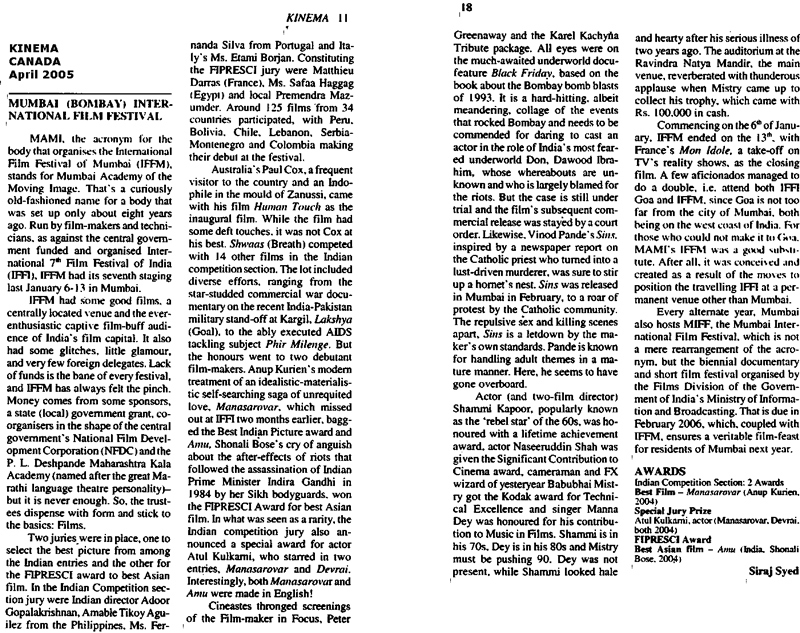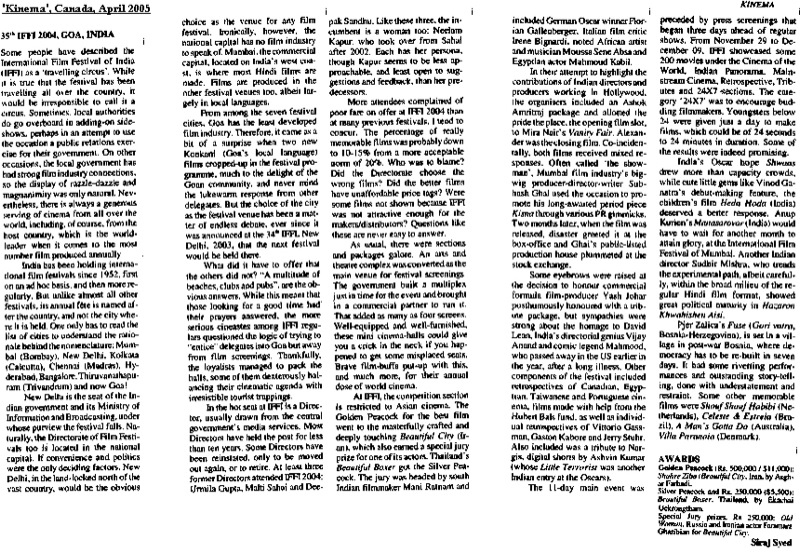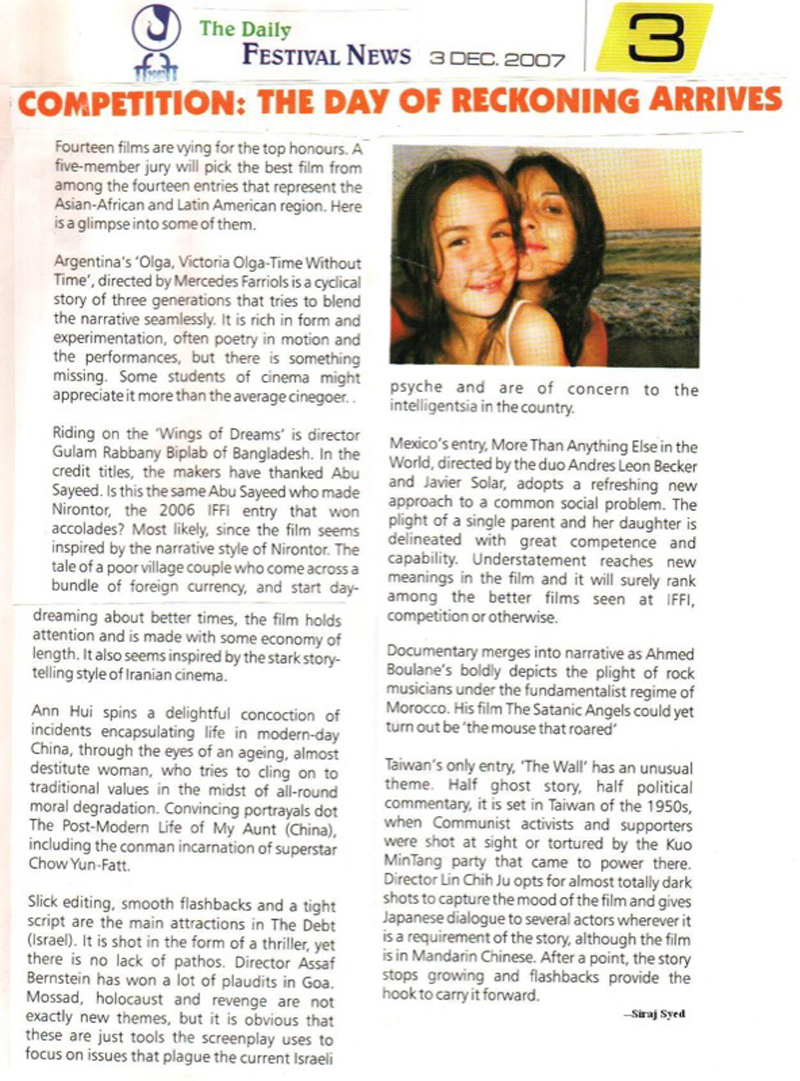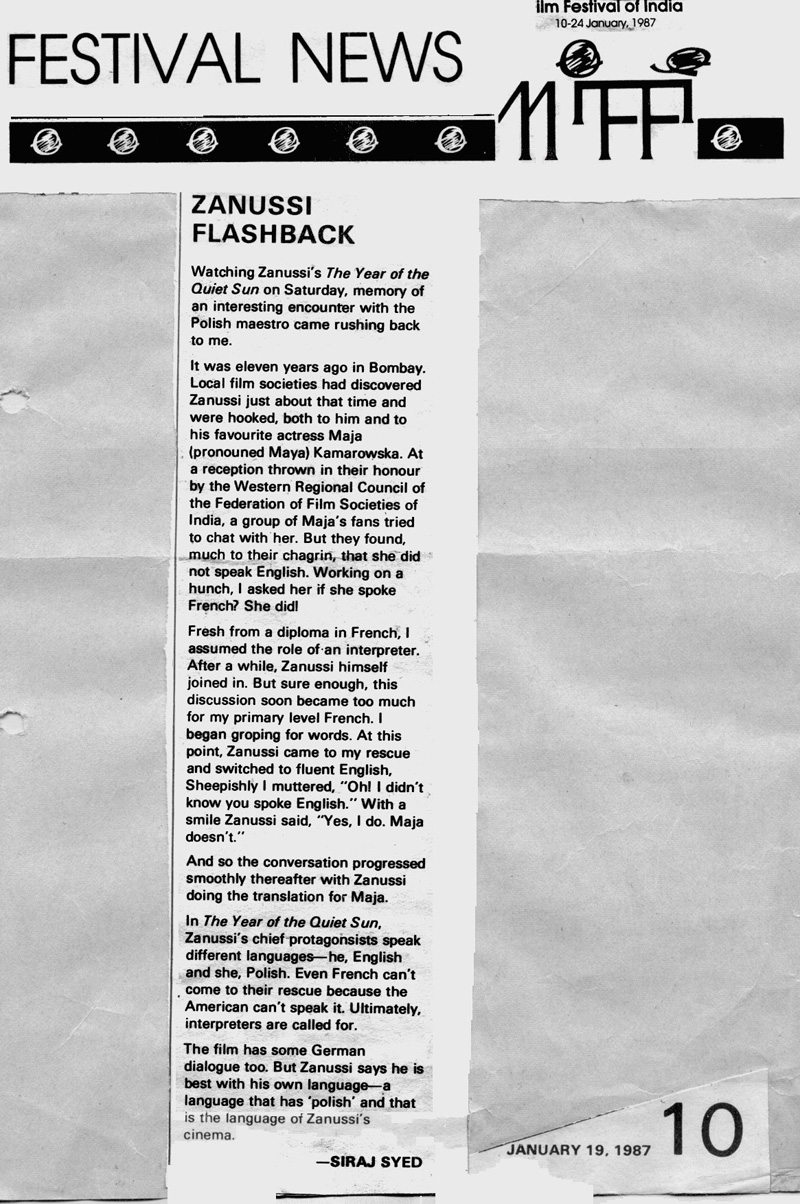|
|
||
|
Pro Tools
FILMFESTIVALS | 24/7 world wide coverageWelcome ! Enjoy the best of both worlds: Film & Festival News, exploring the best of the film festivals community. Launched in 1995, relentlessly connecting films to festivals, documenting and promoting festivals worldwide. Working on an upgrade soon. For collaboration, editorial contributions, or publicity, please send us an email here. User login |
Attack-Part 1, Review: Dawn of a new Ira
Attack-Part 1, Review: Dawn of a new Ira Ira is the new Artificial Intelligence set-up, inspired by Alexa, that is implanted in a soldier who has been paralysed as a result of a bullet wound, converting him into a cyborg. That concept was milked over years in Hollywood films like The Terminator (1984), Terminator 2: Judgment Day (1991), Terminator 3: Rise of the Machines (2003), Terminator Genisys (2015), and Terminator: Dark Fate (2019). Then there was the Universal Soldier series, Universal Soldier (1992), Universal Soldier II: Brothers in Arms (1998), Universal Soldier III: Unfinished Business (1998), Universal Soldier: The Return (1999), Universal Soldier: Regeneration (2009), Universal Soldier: Day of Reckoning (2012). With eleven reference points, and updated technology to boot, how difficult would it be to recreate the universe of these hi-octane tales of an invulnerable ‘part human-part AI soldier’? So, in a kind of extension of the two series, with a new beginning, the makers of Attack used the Covid epidemic to formulate a film, and called it Attack-Part I. Nobody should be blamed if it all looks too familiar. Leading a mission to extract Rehman Gul, leader of a terrorist organisation based on the Kashmir border with Pakistan, and a staunch proponent of war against India, Indian super soldier Arjun Shergill comes across a teenager, Rehman’s son Hamid, who is about to defuse a bomb and blow up the soldiers and himself. Arjun convinces him not to do so, and, in return, spares his life. But Rehman is nowhere to be found. Just when Arjun is about to abort the mission, he sees bullet holes in a ‘wall’ and concludes that there must be somebody hiding behind it. Sure enough, it turns out to be the man himself. That was in 2010. Some ten years later, Arjun is heading to board a flight when an air hostess, Ayesha, bangs into him, rushing home to bring her identity card, which she had forgotten, and the flight is to depart soon. It is love at first sight. A courtship begins, and Arjun proposes to Ayesha. One day, when they are to meet outside the airport, there is a terrorist attack right there, led by Hamid Gul, son of Rehman Gul, who is lodged in an Indian jail. Hundreds are killed, including Ayesha. Arjun is shot in the back and seriously wounded. Doctors opine that he will be paralysed for life, as two of his vertebrae have broken while he fell. But when he comes out of coma, he is able to gain partial control of his body, neck upwards. For the rest, he is paralysed. A doting mother takes great care of him. The first words he utters are “Ayesha, Ayesha”. Meanwhile, Hamid Gul buys chemical weapons from Eastern Europe and launches a full-scale attack on India’s Parliament House. The army chief, Subramaniam, sees an opportunity to test out the new hardware-cum-software package the RDO has been developing, controlled by a chip called Ira, which can not only cure Arjun, but turn him into a super soldier, who can single-handedly eliminate the horde of terrorists who are holding the Prime Minister, other ministers and members of parliament hostage. Nothing new is on offer in the story, which is a tried and trusted formula. There are two little side-tracks that are mildly interesting, though. First is the bumping into each other of Arjun and Ayesha, which, though contrived, still manages to look interesting. The second is the track of the robbers who break into Arjun’s house and steal his mother’s wedding ring. Credit for these side-shows should go either to story writer and co-producer John Abraham himself, or his fellow writers Lakshya Raj Anand, Sumit Batheja and Vishal Kapoor. The rest of the romance between Arjun and Ayesha is copybook writing. One line that brought guffaws at the press screening on Thursday evening was when someone says, “This Home Minister really loves the Prime Minister too much,”, at a high level meeting, where the Home Minister is deputing for the hostage PM but opposes any action against the terrorists that might put the PM’s life in the least bit of danger. In the dialogue, occasionally there is a nice play on words, like on the word ‘turbulence’. For once, the Pakistan-supported terrorists generally speak proper Urdu, unlike the case in many other films of the same genre. But there are loopholes galore. There is not much substance in the way Arjun and Ayesha fall in love. Subramaniam makes a strong claim that the RDO (shortened form of the real government body, DRDO-Defence Research and Development Organisation) is ready for military use, but the developer of the programme, Saba, denies his claim, and insists that it has been developed only to help paralysed patients recover, and regain use of their body parts, not for combat. The strength of the hostages held captive inside Parliament House is given as 300, but remains 300 even after 50 have been released. Parliament House is repeatedly referred to as Parliament, and the attack termed as an attack on the Indian Parliament. What the Indian government, armed forces and intelligence do, if anything, in response to the airport attack is not shown at all. The trick used by Saba to facilitate the escape of the hostages is too simplistic and an example of lazy writing. Shooting of Arjun with just one bullet, when he is at such close quarters, is another. That bullet causes little damage, and his injury is the result of the fall that followed. At a crucial time when Hamid should have been surrounded by body-guards, he decides to walk alone. Apparently in an attempt to safeguard a password, he kills the man who made the chemical bomb detonating programme for him, though the programme has a validity of just twenty minutes, and the man could have been under his eye for those twenty minutes, to ensure no leakage. And how, in heaven’s name, or hell’s name, did Hamid and Co. get to the airport and to Parliament House, several hundred kms. from the Kashmir border, with tons of weapons shall remain an unsolved mystery. Subramanian says that drones were first seen in the movie Star Wars in 1980, though they came into practical usage more than a decade later. Star Wars released its first franchise in 1977, though I cannot confirm when exactly did drones appear in the series. Unmanned Aerial Vehicles (UAVs/drones) were developed much earlier, and the August 1964 clash in the Tonkin Gulf, between naval units of the U.S. and the North Vietnamese Navy, initiated America's highly-classified UAVs (Ryan Model 147, Ryan AQM-91 Firefly, Lockheed D-21) into their first combat missions. Not related to any of the Anands in filmdom, Lakshya Raj Anand, an actor, writer, producer, makes his debut as director, and takes the obligatory credit among the four writers too. He shows us the recovered Arjun getting into great shape by doing a lot of training and work-outs, which I would have thought, would not be necessary at all, given the AI installed. The memories of Ayesha interfering with his AI are a good touch, but the two lovers, who emote hard, fail to strike the right chord. Choosing a newcomer as the arch-villain is always a good move, but did it have to be someone who might have auditioned for a hero’s role and found himself being cast as Mr. Bad Guy? The ‘flying circus’, with almost every opponent sent in a tizzy through the aerial route by Mr. Invincible, hold little or no novelty. And it is not much different from 1001 video games currently doing the rounds on the mobile phones of teens and twenties. That age group might be tempted to see the movie, but the average cinegoer might find the IT jargon overwhelming. Ayesha, visibly, wears a lot of make up all the time, which might be attributed to her job as an air-hostess. But does she have to wear the badge on her left breast all the time, on and off duty? Arguably, John Abraham would be among the top choices for this role, with Tiger Shroff and Vidyut Jamwal too young to play Arjun Shergill. You don’t think of them when you think of Arnold Schwarznegger and Jean Claude van Damme. John’s fights are good and his body remains his main body of work. Some sensitivity is required in the scenes with Saba and his own mother, and he is not bad on that count either, for a change. As producer and actor, he will have to up the ante two notches if wants Attack to become a successful franchise. Jacqueline Fernandez plays Ayesha, and goes over the top time and again. But is always a good ploy to cast her as a model or an air-hostess, where her facial looks blend easily. It’s a brief role, and she dies a few minutes into the film, but her role does not end there. Rakul Preet Singh is beautiful and is in good form too, as Sab,a and steals quite few scenes. Being the only woman on the scene for most of the film, this can be called a parallel lead role. For a change, Prakash Raj is on the right side of the law, as Subramaniam. That name makes us pardon the few Hindustani words that he mispronounces. His intensity and character assimilation is never in doubt. Ratna Pathak Shah has a cameo as Arjun’s mother, which she breezes through with ease. It is sad to see Kiran Kumar wasted in a miniscule role. Serena Walia provides the voice of Ira, and does a good job, but the surprise packet is Elham Ehsas as Hamid Gul. Having worked in the West, in English language films, he makes his Hindustani film debut in Attack, as an Oxford graduate who follows in his father’s footsteps. Except when he is made to indulge in bombast, perhaps to signify that all terrorists are megalomaniacs, is very convincing. Even his boyish good looks do not come in the way of his ruthless persona and meticulous attention to detail. Music by Shashwat Sachdev (who sings too), especially the first two songs, is of a high calibre. However, the music is handicapped by a rhythm that keeps pounding incessantly, irrespective of how gentle and philosophical the lyrics by Kumaar. Three lensmen have worked on the film - Will Humphris, Soumik Mukherjee and P.S. Vinod, and have acquitted themselves well. But in these days of VFX, that too in a sci-fi action film, a lot of the credit must go to the effects department. Film editing by Aarif Sheikh had to be dictated by “more bangs for the buck”, and so we have 123 minutes of viewing time. Yet, to his credit, the film does not drag or bore at any stage. Had this been a path-breaking film, it would earn more encomiums, but when it is weighed against the stuff that has been seen from across the seas over the last 45 years, and in this country over the last decade or so, the plot cannot but look jaded. Bringing in originality in the sci-fi+action genre is a tough ask, as it is in any genre. If Attack is to sustain itself as a series, it will have to work primarily in that direction. Are the makers going to be content with launching AI Ira, or are they going to chip in to create the dawn of a new Era, come Attack-Part 2? Rating: ** Trailer: https://www.youtube.com/watch?v=KnC-XvFGflM 01.04.2022 | Siraj Syed's blog Cat. : Aarif Sheikh Arnold Schwarznegger Artificial Intelligence cyborg DRDO Elham Ehsas HOSTAGES Jacqueline Fernandez Jean Claude Van Damme John Abraham kashmir Kiran Kumar Kumaar Lakshya Raj Anand Lockheed D-21 P.S. Vinod Sachdev Parliament Prakash Raj Rakul Preet Singh Ratna Pathak Ryan AQM-91 Firefly Ryan Model 147 sci-fi Soumik Mukherjee Sumit Batheja Terminator 2: Judgment Day (1991) Terminator 3: Rise of the Machines (2003) Terminator Genisys (2015) Terminator: Dark Fate (2019) The Terminator (1984) Tiger Shroff Tonkin Gulf Universal Soldier (1992) Universal Soldier II: Brothers in Arms (1998) Universal Soldier III: Unfinished Business (1998) Universal Soldier: Day of Reckoning (2012) Universal Soldier: Regeneration (2009) Universal Soldier: The Return (1999) Vidyut Jamwal Vishal Kapoor Will Humphris Independent FILM
|
LinksThe Bulletin Board > The Bulletin Board Blog Following News Interview with IFTA Chairman (AFM)
Interview with Cannes Marche du Film Director
Filmfestivals.com dailies live coverage from > Live from India
Useful links for the indies: > Big files transfer
+ SUBSCRIBE to the weekly Newsletter Deals+ Special offers and discounts from filmfestivals.com Selected fun offers
> Bonus Casino
User imagesAbout Siraj Syed Syed Siraj Syed Siraj (Siraj Associates) Siraj Syed is a film-critic since 1970 and a Former President of the Freelance Film Journalists' Combine of India.He is the India Correspondent of FilmFestivals.com and a member of FIPRESCI, the international Federation of Film Critics, Munich, GermanySiraj Syed has contributed over 1,015 articles on cinema, international film festivals, conventions, exhibitions, etc., most recently, at IFFI (Goa), MIFF (Mumbai), MFF/MAMI (Mumbai) and CommunicAsia (Singapore). He often edits film festival daily bulletins.He is also an actor and a dubbing artiste. Further, he has been teaching media, acting and dubbing at over 30 institutes in India and Singapore, since 1984.View my profile Send me a message The EditorUser contributions |




























